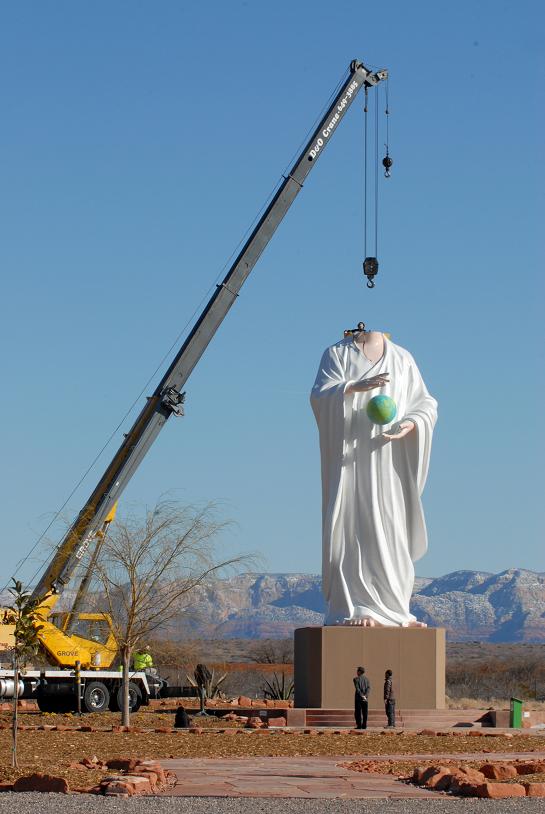The past year was crowded with hundreds of news events that the Cottonwood Journal Extra informed readers about each week. Here are just a few of the biggest stories from 2010.

Mago

 In response to an order from the Cottonwood Planning and Zoning Commission, the Tao Fellowship, a religious organization that operates a visitors park at State Route 89A and Bill Gray Road, removed a 49-foot-tall statue of Mago, a Korean earth goddess, on Feb. 23, one day before a deadline imposed by the city.
In response to an order from the Cottonwood Planning and Zoning Commission, the Tao Fellowship, a religious organization that operates a visitors park at State Route 89A and Bill Gray Road, removed a 49-foot-tall statue of Mago, a Korean earth goddess, on Feb. 23, one day before a deadline imposed by the city.
 A spokeswoman for the organization said removal of the statue from the park cost Tao Fellowship about $25,000. Dozens of other statues, including a giant Kokopelli and figures of several historical and mythical figures, were also removed as a result of the commission’s order.
A spokeswoman for the organization said removal of the statue from the park cost Tao Fellowship about $25,000. Dozens of other statues, including a giant Kokopelli and figures of several historical and mythical figures, were also removed as a result of the commission’s order.
 The commission found Tao Fellowship in violation of a temporary use permit at a hearing that saw hundreds of residents pack the Mingus Union High School auditorium to protest or support the statue.
The commission found Tao Fellowship in violation of a temporary use permit at a hearing that saw hundreds of residents pack the Mingus Union High School auditorium to protest or support the statue.
Hot Air Balloon Crash
Investigators from the Federal Aviation Administration continue to review a midair collision between a hot air balloon and an ultralight aircraft known as a paraplane which occurred shortly before 8 a.m. Oct. 16 during Cottonwood Airfest 2010.
Witnesses said the paraplane appeared to be circling the hot air balloon when they collided. The paraplane became entangled with ropes attached to the balloon and both aircraft began spiraling down to the ground.
Ken Ritchie of Cornville was piloting the paraplane. He was strapped into the aircraft as it fell. Three balloon passengers clung to the inside of the wicker basket as it descended.
Ritchie was allegedly taking photographs when the collision took place.
Clark Mansion Fire
Arson was suspected in the early morning fire that destroyed the historic Clark Mansion on June 25.
The nearly 100-year-old residence, listed on the National Register of Historic Places, was fully engulfed when crews arrived shortly before 5 a.m.
Units from Cottonwood Fire Department and the Sedona, Camp Verde, Clarkdale and Verde Valley fire districts responded. In all, 21 firefighters and 12 units responded to the scene.
“It was a priceless, historical piece of the Verde Valley,” Clarkdale Fire District Fire Chief Joe Moore said. “It’s crushing to have lost it.”
November Elections
Proposition 203, the Arizona Medical Marijuana Act, passed by a slim margin Nov. 2, and marijuana use will soon be legal for people certified as medically eligible.
In response, local officials gathered in Cottonwood in December to discuss ways to make sure the new law is implemented properly without increasing access to the drug for abusers.
During the meeting, some officials argued that establishing a local marijuana dispensary would prevent home-grown marijuana outlets from springing up around the Verde Valley.
Because the act allows people to grow marijuana in their homes when the nearest licensed dispensary is more than 25 miles away, establishing a licensed dispensary locally would push home-grown marijuana operations to residences situated outside the Verde Valley.
Officials said a locally licensed dispensary would also centralize legal marijuana cultivation in a single location that could be monitored and routinely inspected by law enforcement, planning and zoning and health department officials, depending on how far Verde Valley cities and towns decide to go in regulating the industry.
Final rules on implementation of the act promulgated by the Arizona Department of Health are expected in March.
Jerome Grand Hotel
Owners of historic Jerome Grand Hotel Services served notice on Jerome town officials Dec. 15 of their intention to sue the town.
The hotel was closed Dec. 9 after fire and building officials declared it unsafe to occupy. The owners requested a Yavapai County Superior Court judge order the building reopened.
In a press release issued Dec. 8, the town stated the hotel “was deemed as unsafe by the town’s fire official and chief building code official, resulting in its closure following checkout of its guests.”
Owners stated the hotel was one of the safest buildings in Jerome and argued it had made nearly every accommodation demanded by the city.
Water
A surprise inspection of Cottonwood’s water treatment system by Arizona Department of Environmental Quality officials in September won Cottonwood high praise for its work to remove arsenic from city water supplies.
ADEQ officials dropped in Sept. 13 to check on progress at one well, but then announced they would stay to inspect the entire waterworks for compliance with Environmental Protection Agency rules, Public Services General Manager Dan Lueder said.
With the exception of one well, city water contains only trace amounts of arsenic.
“The EPA thought it was very impressive,” said Debbie Breitkreutz, Cottonwood wastewater superintendent. “We’ve only been in the water business for six years. For us to take on 28 wells and actually get remediation working and everything going in one year was quite a feat for a city as small as we are.”
The last well, which supplies water to Verde Village 6, is on track for arsenic remediation technology to be installed before the 2012 deadline imposed by the EPA, Breitkreutz said.



